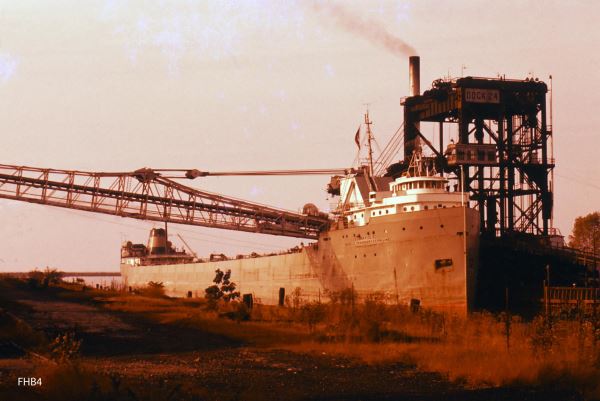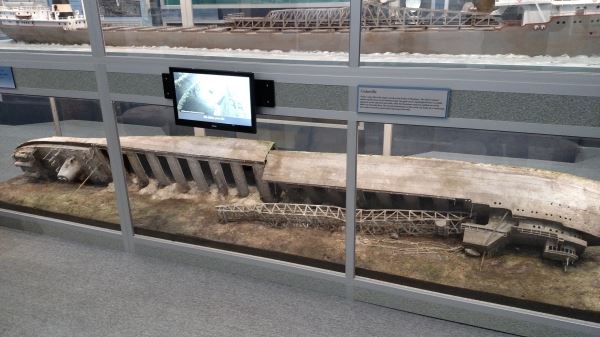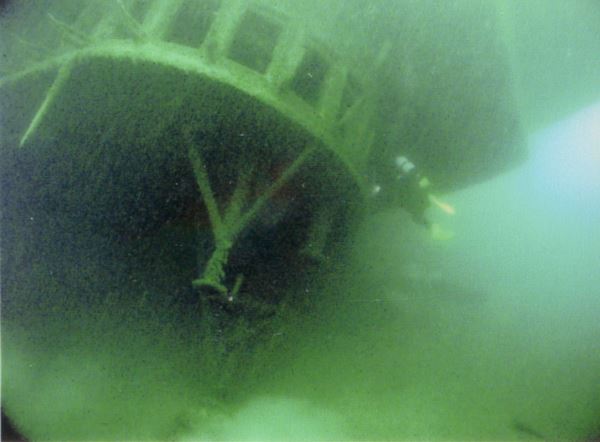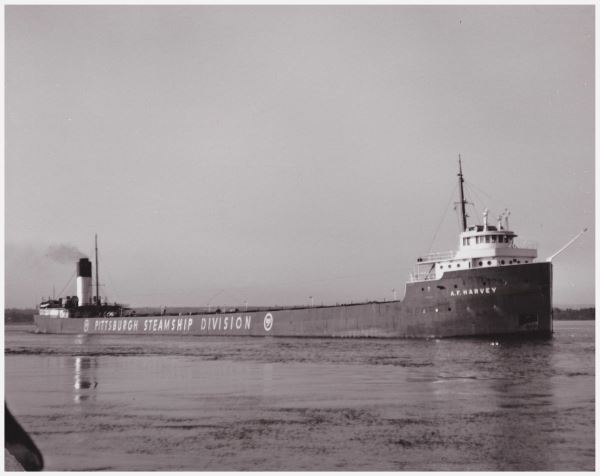 Sitting in the colossal shadow of the Mackinac Bridge, the Cedarville whispers its haunting tale.
Sitting in the colossal shadow of the Mackinac Bridge, the Cedarville whispers its haunting tale.
Back in 1927, the Cedarville was launched at the River Rouge, Mich., as the A.F. Harvey. She was a straight-deck bulk carrier for the Pittsburg Steamship Company (U.S. Steel) and measured in at 604 feet long with a triple expansion steam engine.
On May 7 of 1965, the Cedarville left Port Calcite to go to Gary, Ind., with a crew of 35 men and over 14 thousand tons of limestone. However, they never made it.
The fog thickened as they neared the Straits of Mackinac and due to a lack of communication, they collided with the Norwegian vessel Topdalsfjord. The Cedarville briefly dropped anchor to contact their home office for instructions before their attempt to beach the vessel near Mackinaw City. But then at 10:25am, the Cedarville suddenly rolled over on its starboard side and sank 105 feet down into the water. Ten crew members lost their lives and all but one was recovered.
Full Speed Ahead
Ric Mixter, a prominent shipwreck researcher in the Great Lakes region, has dived over 100 shipwrecks. He has written two books and created 10 videos on the subject, and he had the opportunity to talk with several survivors from the Cedarville to get a more complete story.
Ric met the wheelsman who was at the wheel when it sank, Len Gabrysiak, along with the cook and another crew member named Bob Bingle. He also met Edward Brewster, the crewman who tried to get the lifeboat ready.
“My interviews with those guys became one of my first documentaries called Deep Six,” shared Ric.
He learned from these men that the freighter was in a pea soup fog, and they couldn’t even see the end of their own ship. This meant the captain up front couldn’t see the back end of the ship, yet he was still going full speed. Not only was he going full speed, but he was also headed toward the narrowest part of the channel where the bridge allows shipping traffic to go through.
“At that time, they even saw other ships going through on the radar and he never slowed down,” described Ric. “So it was kind of a rookie mistake for a captain that didn’t have enough training or common sense. I hate to be blunt, but he guessed on where the other ship was going when he couldn’t get radio conversation with the Norwegian vessel, the Topdalsfjord. Yet he still kept going full speed.”
Once the collision occurred, the captain then dropped anchor and tried to call the home office at U.S. Steel to get instructions instead of immediately running for shore. “He was within three miles of the shore, so he could’ve made it,” admitted Ric, “but unfortunately he let out the anchor and called the home office and that cost the men their lives.”
 Popular Shipwreck
Popular Shipwreck
Now the Cedarville is actually one of the most visited shipwrecks on the Great Lakes. This is due to its popular location on the Straits of Mackinac since many people go up there for holidays. It’s also close to the Mackinac Bridge, the crown jewel of Michigan. The shipwreck literally sits in the massive shadow of the bridge.
Of course, not everybody knows about it, but it’s certainly a hotspot for divers. You rarely get to see something as big as a 600-foot-long ship underwater and it’s in relatively good water for diving.
“It’s in 100 feet of water, which is a respectable depth for divers,” noted Ric, “but it’s still not beyond sport diving limits which is 132 feet. Because it’s within sport diving limits and because there’s usually a charter boat up there, it’s very visited.”
The Cedarville landed upside down and because it’s in a strait, the connection between Lake Michigan and Huron, there’s a current that passes through the area of the shipwreck. This makes it a fairly difficult dive and since it’s upside down, that means there isn’t a way to safely go in without going in a hundred feet deep to get inside the ship.
This makes it so you can’t spend too much time in there. Ric has been inside the cargo hold and the pilot house, and other divers have gone through the engine room and all the other rooms. If you plan on diving the Cedarville shipwreck, Ric suggests some caution and to never dive beyond your capabilities.
“Sadly, people have died trying to explore that shipwreck,” cautioned Ric. “It’s not a good penetration wreck when conditions are bad, but on a good day, it should be respected. You need to use special lines and extra air. It’s a challenging dive if you plan to go inside.”
Always Remember
Since the Cedarville sank fairly recently, there are still many people with strong connections to it. Dan Friedhoff, the secretary of the Straits of Mackinac Shipwreck Preserve Association is one such individual. One of his earliest memories is of being taken aboard the Cedarville by his father who spent most of his short sailing career on board.
“He became a sailor when the vessel came out of Bay City’s Defoe Shipyard after being converted to a self-unloader in 1958,” shared Dan, “and he ended his career after surviving the sinking in 1965.”
For Ric, when it comes to any shipwreck it’s about the people who survived and sadly, the people who were lost. “That’s what we remember when we dive any shipwreck. The majority have had lives lost and the Cedarville still has one guy that hasn’t been found. These are shipwrecks—these are accidents that happened on the Lakes and they’re graveyards.”
Resting in the shadow of the Mackinac Bridge, the Cedarville will continue to tell its haunting tale for many years to come.
Lake Fury
If you love learning about shipwrecks on the Great Lakes, be sure to check out Ric Mixter’s books, documentaries and podcasts. You can find them on his website www.lakefury.com.

